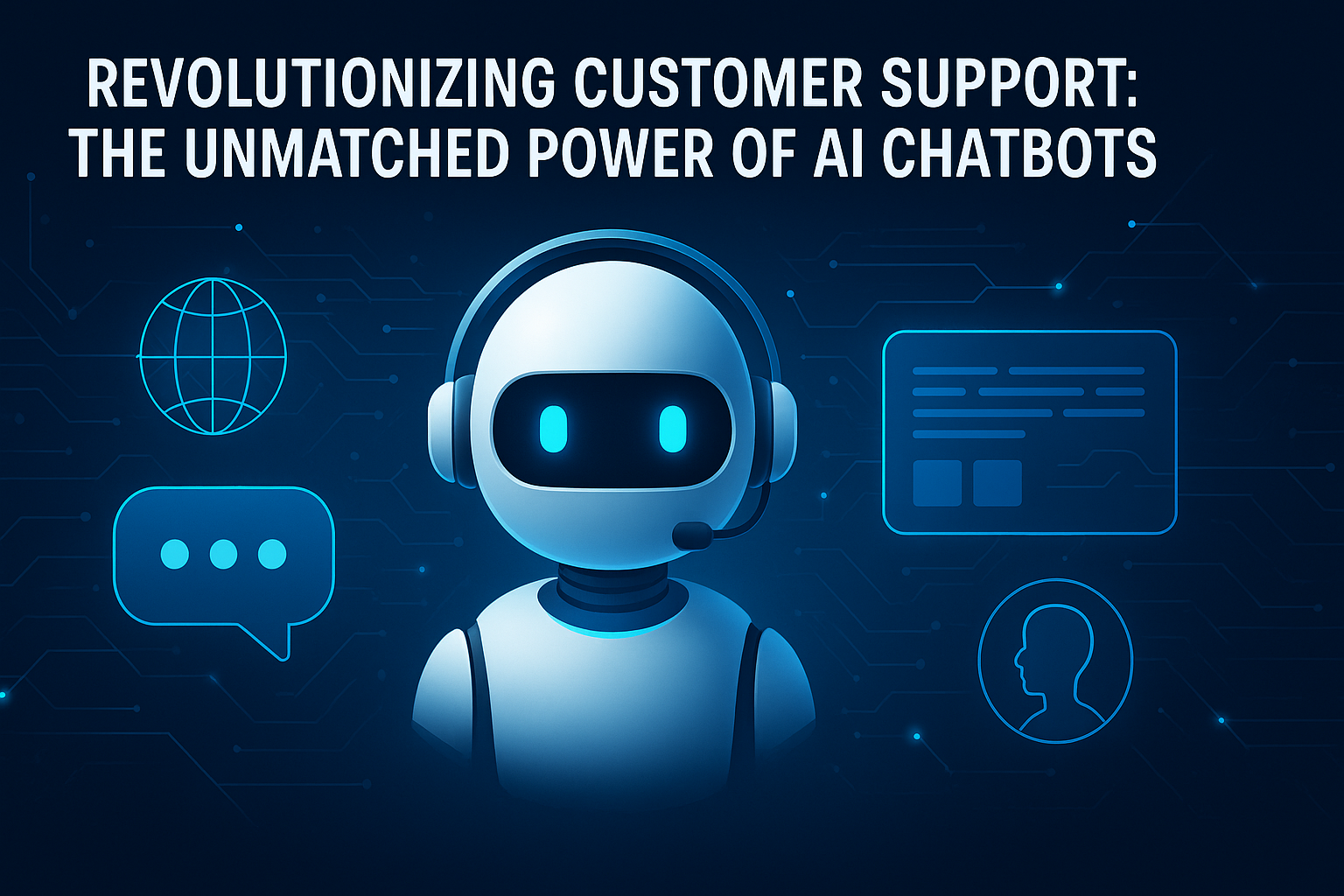
Introduction to AI Chatbots in Customer Service
Remember the days of waiting endlessly on hold for a support agent to pick up your call? Those days are fading fast. As technology reshapes every industry, customer service is undergoing a radical transformation—and AI chatbots are at the heart of this revolution.
In today’s digital-first world, customers expect instant gratification. Whether it’s checking an order status at midnight or resolving a billing issue during a weekend, they want answers—now. That’s where AI chatbots step in, offering a level of speed, scale, and convenience that traditional methods simply can’t match.
What Are AI Chatbots?
AI chatbots are smart software programs designed to simulate human-like conversations. Unlike rule-based bots that respond to specific commands, AI-powered chatbots use Natural Language Processing (NLP) and Machine Learning (ML) to understand intent, interpret queries, and respond accordingly.
These bots don’t just “speak robot.” They learn over time, adapt to new questions, and can handle ambiguity with grace—making interactions feel more human and less like talking to a machine.
The Evolution of Customer Service
Back in the day, customer service meant phone calls, long wait times, and transferring between departments. Then came emails, live chat, and self-service portals. But even these improvements have limitations when businesses face high volumes or global audiences.
AI chatbots are the next natural step in this evolution. They offer instant, accurate, and friendly support—without the overhead of large teams or the risk of human burnout.
Key Advantages of Implementing AI Chatbots
Let’s talk benefits—because AI chatbots aren’t just trendy tools; they’re game-changers.
Imagine a customer needing help at 2 AM. With a chatbot, that’s no problem. AI doesn’t need sleep or coffee breaks. Your customers get support whenever they need it—no matter the time zone.
Customers hate waiting. A chatbot responds in seconds, reducing friction and improving satisfaction. Even during peak hours, bots maintain their speed.
Hiring, training, and managing large support teams is expensive. AI chatbots handle high volumes at a fraction of the cost, allowing you to invest those savings elsewhere in your business.
No queue, no hold time. Chatbots can talk to 10 or 10,000 customers at once—something no human team could do effectively.
Got a holiday sale or a sudden viral product? No need to panic. Chatbots scale up effortlessly, ensuring every customer gets the support they need—instantly.
Enhanced Customer Experience with AI Chatbots
Modern consumers value convenience and personalization—and chatbots deliver both.
Thanks to NLP, chatbots can understand slang, sentiment, and tone. They use past interactions to tailor responses, making customers feel heard and valued.
Language barriers? Not anymore. Many chatbots can speak multiple languages fluently, letting you support customers from Mumbai to Madrid with ease.
Good chatbots don’t forget. They remember past interactions and context, reducing repetition and creating smoother, more natural conversations.
Business Efficiency and Operational Improvements
Chatbots aren’t just customer-facing tools—they streamline internal operations too.
Unlike human agents, bots don’t mishear or forget. They deliver consistent, accurate answers every single time.
Password resets, shipping updates, and FAQs? Let bots handle the routine so your team can focus on complex, high-value interactions.
Every conversation is a goldmine of data. AI chatbots analyze this data to identify patterns, predict customer behavior, and improve services.
Use Cases Across Industries
AI chatbots aren’t one-size-fits-all. They adapt brilliantly across sectors:
From product recommendations to order tracking, bots are like virtual personal shoppers guiding users through their buying journey.
Chatbots can schedule appointments, remind patients of checkups, and answer common health queries—lightening the load on medical staff.
In finance, bots assist with balance checks, fraud alerts, and transaction histories—while maintaining high security standards.
Need a flight update or hotel suggestion? Chatbots are travel companions offering instant help, itinerary changes, and local tips.
AI Chatbots vs Human Agents: A Collaboration, Not a Competition
Contrary to popular belief, AI isn’t here to replace humans—it’s here to enhance them.
AI handles repetitive, high-volume tasks. This frees up human agents to solve complex problems and deliver empathetic service when it matters most.
AI chatbots can feed agents relevant data mid-chat, suggest solutions, or summarize past interactions—supercharging their performance.
Common Challenges and Misconceptions
Let’s bust a few myths.
With today’s advanced NLP, bots can sound surprisingly human. And when designed right, they make conversations more efficient—not robotic.
Reputable chatbot platforms are built with end-to-end encryption and GDPR compliance. Security is no longer a dealbreaker.
AI shifts roles—it doesn’t eliminate them. Support agents evolve into supervisors, analysts, and chatbot trainers.
The Future of AI Chatbots in Customer Service
Where’s all this headed? Even more magic is on the horizon.
Imagine bots that know your preferences, order history, tone, and intent. That’s where we’re going—deep personalization on a mass scale.
Voice-enabled chatbots are the next big leap, blending convenience with accessibility.
Tomorrow’s bots won’t just respond—they’ll anticipate needs and offer help before you even ask.
How to Successfully Implement AI Chatbots
Ready to jump in? Here’s how to do it right.
Pick a chatbot solution that integrates with your existing systems, supports NLP, and allows easy customization.
Script conversations thoughtfully. Add humor, empathy, and logic to create engaging dialogues.
Train your bot regularly. Use customer feedback and analytics to optimize its responses and stay relevant.
Don’t fly blind—track these to gauge chatbot impact:
Customer Satisfaction Scores (CSAT)
Ask customers how they felt about the interaction. High CSAT = bot is doing its job.
First Response Time (FRT)
The quicker the bot replies, the better the experience.
Chatbot Containment Rate
How often can the bot handle issues without human help? This reflects efficiency and cost-saving potential.
Final Thoughts on the AI Chatbot Advantage
AI chatbots aren’t a passing trend—they’re the future of smart customer service. From cutting wait times to delivering personalized experiences and improving business efficiency, the advantages are undeniable.
The biggest advantage? It’s not just one thing. It’s the combination of speed, availability, personalization, and scalability that makes AI chatbots an essential tool for modern businesses.
FAQs
1. Can AI chatbots understand complex or emotional queries?
Yes, advanced chatbots use sentiment analysis to detect emotion and respond empathetically. While they’re not perfect, they’re constantly improving.
2. Are chatbots expensive to implement for small businesses?
Many chatbot platforms offer affordable plans for startups and SMEs, and the long-term ROI often outweighs the upfront cost.
3. What industries benefit most from AI chatbots?
Virtually all—eCommerce, finance, healthcare, travel, education, and even government sectors are leveraging chatbots for better service.
4. Can chatbots replace customer support teams?
Not entirely. They’re great for handling routine queries but still need human agents for complex, sensitive, or emotional cases.
5. How secure are AI chatbot conversations?
Top platforms use encryption and follow strict compliance standards to ensure user data is protected.

